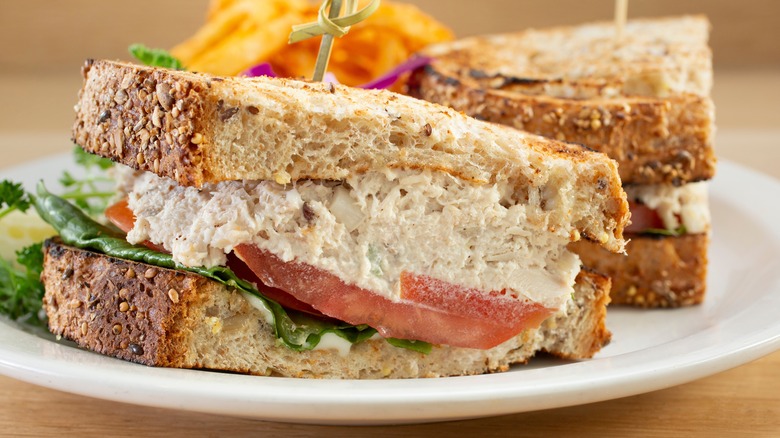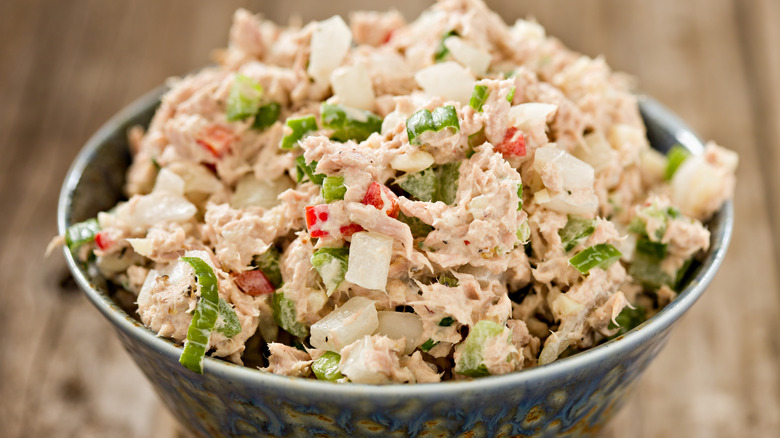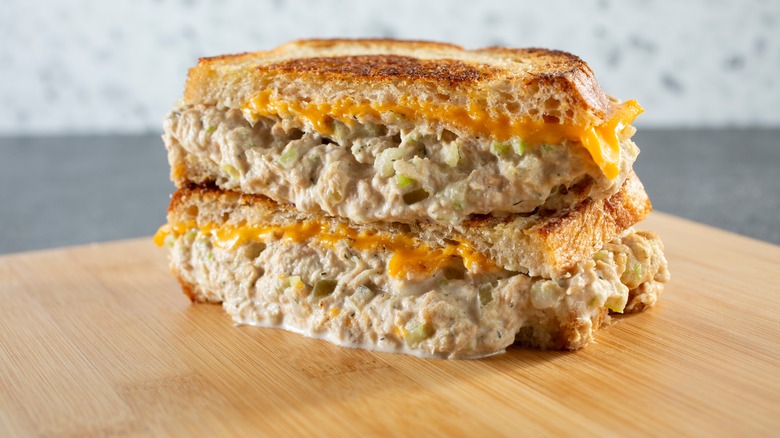The Tuna Salad Sandwich Was Born From Scrappy Cooking (Literally)
The tuna salad sandwich is one of the most widely consumed lunch foods in the United States. The National Fisheries Institute estimates that Americans eat about 1 billion pounds of tuna per year, and that 52% of it ends up in tuna salad sandwiches. Even today, consumers are still so taken with the convenience of canned tuna that it remains the only regularly consumed seafood at lunchtime.
But the dish didn't start out with such a strong reputation. Like many classic American foods, such as hamburgers, pizza, and hot dogs, the tuna salad sandwich had to rise from obscure, working-class origins around the turn of the 20th century to become a staple food. In the days before canned tuna, sandwiches were made from literal scraps of dinner meat and served for lunch the next day.
The hamburger is one example: Its meat patties were originally made from ground pieces of low-grade beef known as "hamburg steak" in the early 20th century. And hot dogs were traditionally made from pieces of beef and pork that went unused during the butchering process and were stuffed into a sausage casing. All of these "scrap meat" dishes would come to be served between two pieces of bread before attaining mass popularity, setting the stage for tuna salad to come on the scene.
Tuna meat transforms from leftovers to lunch
In the 19th century, Americans couldn't just walk into their local supermarket and purchase 5 pounds of meat. Prior to the industrialization of the meat industry, it was typically available in lesser quantities, and most Americans relied on local producers rather than the mass distribution systems prevalent today.
Because protein was harder to come by, home cooks avoided wasting meat as much as possible. Leftover dinner scraps of chicken, ham, or fish would be mixed with mayonnaise and served on lettuce for lunch the next day as a makeshift salad. In fact, the salad nomenclature that survives today originated with this early use of lettuce as a container for the dressed meat.
As tuna emerged as a popular canned meat in the early 20th century (thanks to an aggressive public relations campaign in 1910s), it paved the way for the dramatic rise in popularity of the tuna salad sandwich to come. Media messaging, plus the demand for food rations for soldiers waging World War I in Europe created a tremendous demand for canned tuna. Another significant development is that sliced bread became commercially available in the late 1920s, further adding to the convenience factor.
As women entered the workforce during World War II, lunch counters also began catering more to their tastes, offering salads that incorporated canned tuna, rather than the former scrappy meats. Cooks began serving made-to-order tuna salad between two slices of bread for greater portability, and in no short order, the sandwich quickly became popular among working-class Americans.
How to elevate a tuna salad sandwich
Due to its ease and convenience, a tuna salad sandwich remains an excellent lunchtime option, especially for working professionals. In its most basic form, a tuna salad sandwich will only require some canned tuna, mayo, and sliced bread. But adding acidic ingredients like lemon, dijon mustard, or vinegar will enhance the freshness of the fish and help avoid what one chef calls the biggest mistake when making tuna salad.
Other excellent additions include jalapeños, olives, capers, or hot cherry peppers. You can try using Greek yogurt to impart some tang when you want some tuna salad without mayo. The fishy taste can also be heightened by adding savory ingredients like red onion, dill, celery, and black pepper.
Although typically eaten cold, the tuna salad sandwich can also be enjoyed hot, too, as in the case of a tuna melt (which was first created after a happy mistake). Popular legend claims that a chef in the early '60s mistakenly added tuna salad to a grilled cheese sandwich before putting it into a broiler. The resulting gooey, melty fish sandwich became a hit just as much as the tuna salad sandwich was in its early days. A tuna melt can be easily created at home with cheese such as Swiss or pepper jack, on slices of toasted rye or sourdough.



